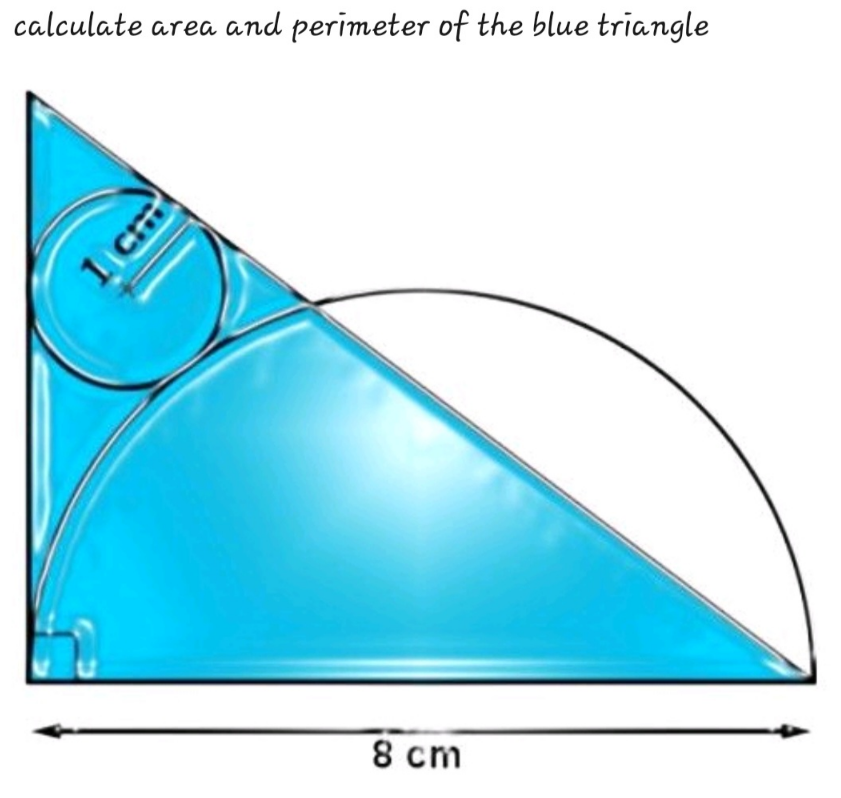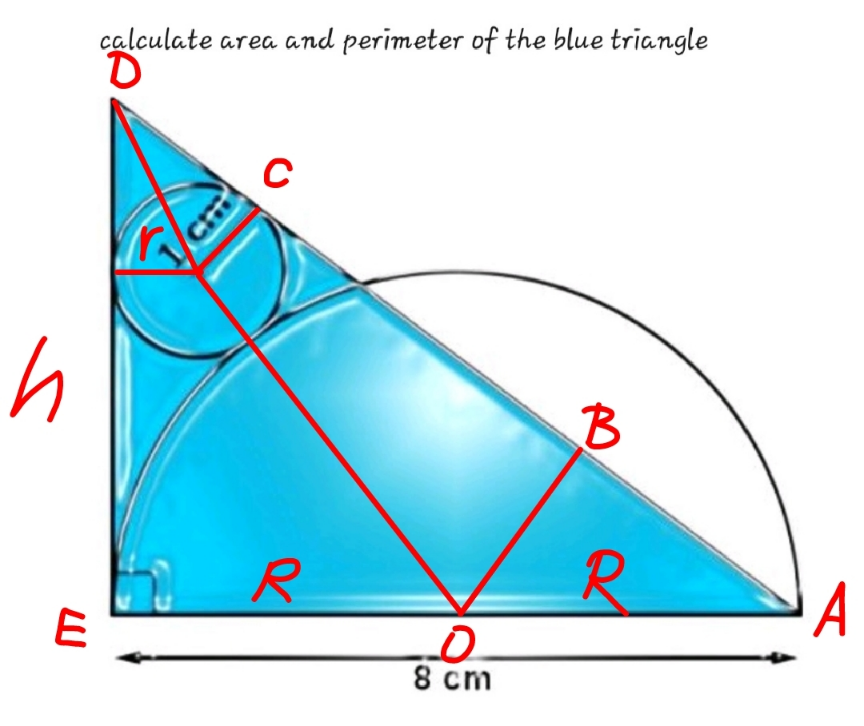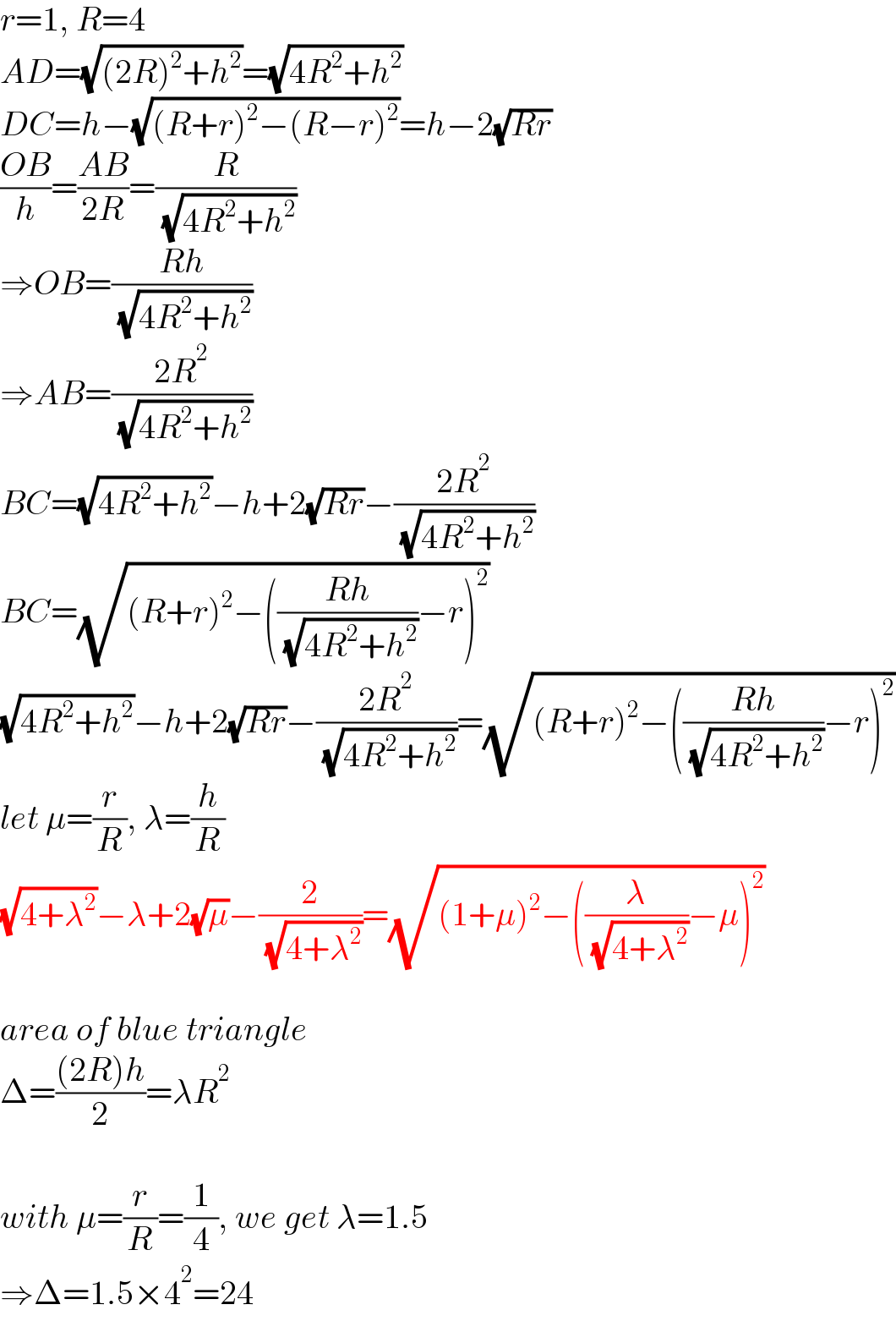
Question Number 191275 by Mingma last updated on 22/Apr/23

Answered by mr W last updated on 22/Apr/23

Commented by mr W last updated on 22/Apr/23

$${r}=\mathrm{1},\:{R}=\mathrm{4} \\ $$$${AD}=\sqrt{\left(\mathrm{2}{R}\right)^{\mathrm{2}} +{h}^{\mathrm{2}} }=\sqrt{\mathrm{4}{R}^{\mathrm{2}} +{h}^{\mathrm{2}} } \\ $$$${DC}={h}−\sqrt{\left({R}+{r}\right)^{\mathrm{2}} −\left({R}−{r}\right)^{\mathrm{2}} }={h}−\mathrm{2}\sqrt{{Rr}} \\ $$$$\frac{{OB}}{{h}}=\frac{{AB}}{\mathrm{2}{R}}=\frac{{R}}{\:\sqrt{\mathrm{4}{R}^{\mathrm{2}} +{h}^{\mathrm{2}} }} \\ $$$$\Rightarrow{OB}=\frac{{Rh}}{\:\sqrt{\mathrm{4}{R}^{\mathrm{2}} +{h}^{\mathrm{2}} }} \\ $$$$\Rightarrow{AB}=\frac{\mathrm{2}{R}^{\mathrm{2}} }{\:\sqrt{\mathrm{4}{R}^{\mathrm{2}} +{h}^{\mathrm{2}} }} \\ $$$${BC}=\sqrt{\mathrm{4}{R}^{\mathrm{2}} +{h}^{\mathrm{2}} }−{h}+\mathrm{2}\sqrt{{Rr}}−\frac{\mathrm{2}{R}^{\mathrm{2}} }{\:\sqrt{\mathrm{4}{R}^{\mathrm{2}} +{h}^{\mathrm{2}} }} \\ $$$${BC}=\sqrt{\left({R}+{r}\right)^{\mathrm{2}} −\left(\frac{{Rh}}{\:\sqrt{\mathrm{4}{R}^{\mathrm{2}} +{h}^{\mathrm{2}} }}−{r}\right)^{\mathrm{2}} } \\ $$$$\sqrt{\mathrm{4}{R}^{\mathrm{2}} +{h}^{\mathrm{2}} }−{h}+\mathrm{2}\sqrt{{Rr}}−\frac{\mathrm{2}{R}^{\mathrm{2}} }{\:\sqrt{\mathrm{4}{R}^{\mathrm{2}} +{h}^{\mathrm{2}} }}=\sqrt{\left({R}+{r}\right)^{\mathrm{2}} −\left(\frac{{Rh}}{\:\sqrt{\mathrm{4}{R}^{\mathrm{2}} +{h}^{\mathrm{2}} }}−{r}\right)^{\mathrm{2}} } \\ $$$${let}\:\mu=\frac{{r}}{{R}},\:\lambda=\frac{{h}}{{R}} \\ $$$$\sqrt{\mathrm{4}+\lambda^{\mathrm{2}} }−\lambda+\mathrm{2}\sqrt{\mu}−\frac{\mathrm{2}}{\:\sqrt{\mathrm{4}+\lambda^{\mathrm{2}} }}=\sqrt{\left(\mathrm{1}+\mu\right)^{\mathrm{2}} −\left(\frac{\lambda}{\:\sqrt{\mathrm{4}+\lambda^{\mathrm{2}} }}−\mu\right)^{\mathrm{2}} } \\ $$$$ \\ $$$${area}\:{of}\:{blue}\:{triangle} \\ $$$$\Delta=\frac{\left(\mathrm{2}{R}\right){h}}{\mathrm{2}}=\lambda{R}^{\mathrm{2}} \\ $$$$ \\ $$$${with}\:\mu=\frac{{r}}{{R}}=\frac{\mathrm{1}}{\mathrm{4}},\:{we}\:{get}\:\lambda=\mathrm{1}.\mathrm{5} \\ $$$$\Rightarrow\Delta=\mathrm{1}.\mathrm{5}×\mathrm{4}^{\mathrm{2}} =\mathrm{24} \\ $$
Commented by Mingma last updated on 22/Apr/23
Excellent, sir!
